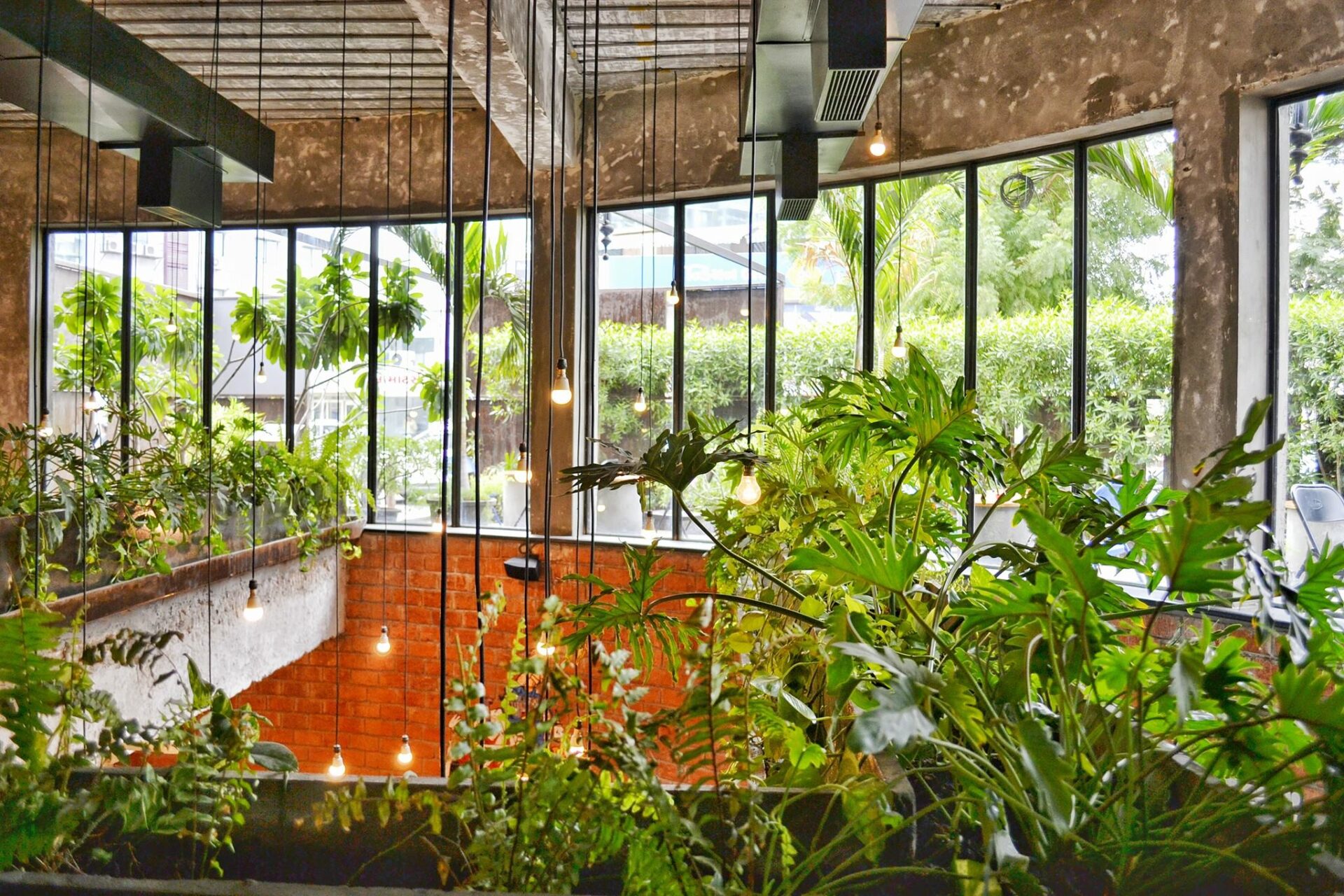As winter approaches, many gardening enthusiasts may feel disheartened by the thought of their beloved plants withering away in the cold. However, indoor vertical gardening offers a fantastic solution to keep your green thumb active during the frosty months.
In this article, we will delve into the world of indoor vertical gardens and explore the essential elements required to create a thriving green space within the confines of your home. We will discuss the importance of selecting suitable plants, providing adequate light and temperature, and ensuring proper watering and nutrient management. We will also give you many other Winter Indoor Vertical Garden Tips to create a garden that will look good all year round.
Following our comprehensive guide, you can transform a barren indoor space into a lush living garden that flourishes throughout winter.
Indoor Vertical Garden Setup and Design Tips
Creating a thriving indoor vertical garden during winter requires thoughtful planning and design. This section will provide valuable Winter Indoor Vertical Garden Tips and insights to help you establish a productive and visually appealing vertical garden within your indoor space. We will cover various topics, including choosing the right plants, selecting the perfect containers, and optimizing light and temperature conditions.
Choosing the Right Plants for Your Indoor Vertical Garden
The first step in designing an indoor vertical garden is selecting the appropriate plants. When choosing plants for your vertical garden, consider light requirements, growth habits, and temperature preferences. Opt for plants that can thrive in the specific conditions of your indoor space.
Some popular choices for indoor vertical gardens include ferns, pothos, and spider plants. Consider incorporating edible plants, such as herbs and leafy greens, which can add flavor and visual appeal to your indoor garden.
Selecting the Perfect Indoor Vertical Garden Containers
Once you have chosen the plants for your indoor vertical garden, it’s time to select the appropriate containers. The containers you choose will not only influence your garden’s overall appearance but also impact your plants’ health and growth. Various container options are available, from traditional pots and planters to modular systems specifically designed for vertical gardening.
Be sure to choose containers with proper drainage and consider weight and ease of installation. For more detailed information on selecting suitable containers, check out our article “How to Select the Perfect Indoor Vertical Garden Containers.“
Optimizing Light and Temperature Conditions for Plant Growth
Adequate light and temperature are crucial elements for the success of your indoor vertical garden. During winter, natural sunlight may be limited, so providing supplemental lighting for your plants is essential. Choose grow lights that mimic the sun’s spectrum and adjust the duration and intensity according to your plants’ needs.
Additionally, maintain a consistent temperature within your indoor space, ensuring it falls within the optimal range for your selected plant species. This will promote healthy growth and prevent wilting or stunted growth.
Maintaining Proper Watering and Nutrient Management
Proper watering and nutrient management are essential for a thriving indoor vertical garden. Since vertical gardens often have limited soil volume, it is crucial to ensure your plants receive adequate water and nutrients.
Develop a regular watering schedule based on your plant’s needs, and consider using self-watering containers or drip irrigation systems for more efficient water management. Furthermore, provide your plants with appropriate nutrients using high-quality organic fertilizers or nutrient-rich potting mixes to support their growth and overall health.
With these indoor vertical garden setup and design tips, you can create a flourishing green space within your home during winter. By carefully selecting plants and containers and optimizing growing conditions, your indoor vertical garden will not only add visual appeal to your living space but also provide a haven for nurturing your favorite plants throughout the colder season.
Managing Temperature and Humidity in Indoor Gardens
Creating a thriving indoor vertical garden in winter requires careful management of temperature and humidity, which play crucial roles in the health and growth of your plants. This subsection will discuss Winter Indoor Vertical Garden Tips about maintaining optimal temperature and humidity levels in your indoor garden. We will also provide practical tips on achieving the ideal growing conditions for your plants.
Understanding the Importance of Temperature and Humidity in Plant Growth
Temperature and humidity are two key factors that directly influence plant growth. Plants generally thrive in specific temperature and humidity ranges. If the temperature is too high or too low, it can lead to stunted growth, leaf drop, or even plant death. Similarly, improper humidity levels can cause mold growth, nutrient imbalances, and poor root development.
Monitoring and Adjusting Temperature in Your Indoor Vertical Garden
To ensure the success of your indoor vertical garden, regularly monitor the temperature of your growing space using a reliable indoor thermometer. Most plants prefer a consistent temperature range of 65-75°F (18-24°C) during the day and a slightly more incredible range of 55-65°F (13-18°C) during the night.
To maintain these ideal temperatures, consider using a space heater or a programmable thermostat to adjust the temperature. Moreover, be mindful of the placement of your plants, as areas near windows or exterior walls may experience temperature fluctuations.
Controlling Humidity Levels for Optimal Plant Growth
Maintaining appropriate humidity levels is equally vital for the well-being of your indoor vertical garden. Most plants thrive in a relative humidity range of 40-60%. To monitor humidity levels, invest in a hygrometer and take regular readings.
If humidity levels are too low, you can increase them by using a humidifier or placing a tray filled with water and pebbles beneath your plants. Conversely, if humidity levels are too high, consider using a dehumidifier or increasing air circulation with fans.
How to Start an Indoor Vertical Garden on a Budget
Creating a thriving indoor vertical garden doesn’t have to be an expensive endeavor. Following our guide on “How to Start an Indoor Vertical Garden on a Budget,” you can learn cost-effective strategies to establish a flourishing indoor garden without breaking the bank. In addition to tips on affordable containers and plant selection, our guide also provides valuable insights on how to manage temperature and humidity in a budget-friendly manner.
Managing temperature and humidity in your indoor vertical garden is essential for promoting healthy plant growth and preventing common issues like wilting or mold growth. By regularly monitoring and adjusting the temperature and humidity levels in your growing space, you can ensure the ideal growing conditions for your plants and enjoy a lush, thriving indoor garden throughout the winter months.
Choosing the Right Plants for Winter Vertical Gardens
Selecting suitable plants is of utmost importance when it comes to creating a successful indoor vertical garden during the winter months. This subsection will explore various Winter Indoor Vertical Garden Tips to consider when choosing plants for your winter vertical garden and some popular plant options that thrive in indoor environments.
You can establish a lush, flourishing garden that provides enjoyment and satisfaction throughout the cold season by picking the appropriate plants.
Considering Light Requirements and Growth Habits
The first step in choosing the right plants for your winter vertical garden is to evaluate potential plant candidates’ light requirements and growth habits. Since natural sunlight is often limited during winter, opt for plants that thrive in low-light conditions or adapt well to artificial lighting. Additionally, consider selecting plants with compact growth habits to maximize the available space in your vertical garden.
Focusing on Cold-Tolerant and Indoor-Friendly Species
Another essential factor to consider is your chosen plants’ cold tolerance and indoor adaptability. While your indoor vertical garden will be protected from harsh outdoor elements, it is crucial to select plant species that can thrive in the cooler indoor temperatures typically experienced during winter.
Furthermore, opt for plants that adapt well to indoor environments. They will likely require less maintenance and have a higher success rate in your vertical garden.
Popular Plant Options for Winter Vertical Gardens
With these factors in mind, here are some popular plant options that are well-suited for winter vertical gardens:
1. Pothos (Epipremnum aureum): This low-light-tolerant plant is perfect for indoor vertical gardens. It easily adapts to artificial lighting and has a beautiful trailing growth habit.
2. Ferns: Various fern species, such as the Boston fern (Nephrolepis exaltata) and maidenhair fern (Adiantum spp.), can thrive indoors and are known for their elegant, feathery foliage.
3. Snake plant (Sansevieria trifasciata): With its striking, upright leaves, the snake plant is an excellent choice for adding visual interest to your vertical garden. It is also highly adaptable to various light conditions and can tolerate cooler temperatures.
4. Spider plant (Chlorophytum comosum): This popular houseplant is known for its cascading growth habit, making it an ideal choice for vertical gardens. It can also tolerate low light conditions and cooler indoor temperatures.
5. Herbs and leafy greens: Incorporate edible plants like basil, parsley, and lettuce into your winter vertical garden for added functionality and visual appeal. These plants typically have compact growth habits and can be grown successfully under artificial lighting.
By carefully considering factors such as light requirements, growth habits, and cold tolerance, you can successfully choose the right plants for your winter vertical garden. This thoughtful selection process will help you establish a thriving indoor garden and ensure that your vertical garden remains a beautiful and enjoyable space throughout the winter months.
Winter Plant Care and Maintenance for Vertical Gardens
As you embark on your journey to create a thriving indoor vertical garden during winter, it’s essential to understand your plants’ unique care and maintenance requirements.
This subsection will explore various Winter Indoor Vertical Garden Tips for winter plant care, focusing on proper watering, fertilization, pruning, and pest management. Following these guidelines ensures that your indoor vertical garden remains healthy and vibrant throughout the colder months.
Watering Wisely: Adjusting Your Watering Schedule for Winter
Your plants’ watering needs may differ during winter from those during warmer months. As a result, it’s vital to adjust your watering schedule accordingly. Plants require less water during winter due to reduced sunlight, lower temperatures, and slower growth rates.
Be sure to monitor the moisture levels of your plants’ soil and avoid overwatering, as this can lead to root rot and other issues. To maintain optimal moisture levels, consider using a moisture meter or simply checking the soil with your finger before watering.
Feeding Your Plants: Winter Fertilization Tips
Like their watering needs, plants typically require fewer nutrients during winter. This is mainly due to their slower growth rate and reduced metabolic activity. To ensure your plants receive the appropriate amount of nutrients during this time, consider reducing the frequency and quantity of fertilization. Additionally, opt for a slow-release, organic fertilizer that can provide a gentle and consistent supply of nutrients to your plants throughout the season.
Pruning and Trimming: Encouraging Healthy Growth
Pruning and trimming your plants during winter can help maintain their shape, encourage healthy growth, and promote better air circulation within your indoor vertical garden. Regularly inspect your plants for dead or damaged leaves and stems, and remove them using clean, sharp pruning shears or scissors. This will improve the overall appearance of your vertical garden and reduce the risk of disease and pest infestations.
Keeping Pests at Bay: Winter Pest Management Strategies
While indoor vertical gardens are generally less susceptible to pests than outdoor gardens, it’s still important to remain vigilant and implement effective pest management strategies during winter. Regularly inspect your plants for signs of infestations, such as discolored leaves, webbing, or the presence of pests themselves.
If you detect any issues, act promptly to address them using natural pest control methods, such as introducing beneficial insects, applying neem oil, or using insecticidal soap.
By paying close attention to your plants’ unique care and maintenance requirements during winter, you can ensure the health and vitality of your indoor vertical garden. Adjusting your watering and fertilization schedules, performing regular pruning and trimming, and implementing effective pest management strategies will all contribute to the success of your winter indoor garden. With diligent care and attention, your vertical garden will remain a lush and thriving sanctuary throughout the colder months.
Lighting Solutions for Winter Gardening Success
As winter brings shorter days and less sunlight, providing adequate lighting for your indoor vertical garden becomes crucial for its success. In this subsection, we will explore various lighting solutions to help your plants thrive during winter.
We will discuss the importance of choosing the right type of artificial lighting, optimizing the duration and intensity of light exposure, and understanding the specific light requirements of your chosen plants. By implementing these lighting solutions, you can ensure that your indoor vertical garden continues flourishing even in the darkest days of winter.
Selecting the Right Type of Artificial Lighting
When providing artificial light for your winter indoor vertical garden, choosing the right type of lighting is essential. Several options are available, each with its own advantages and drawbacks. Some popular options include fluorescent lights, LED grow lights and high-intensity discharge (HID) lamps.
While fluorescent lights are energy-efficient and affordable, LED grow lights often provide a more comprehensive light spectrum, closely mimicking natural sunlight. On the other hand, HID lamps are highly intense but can generate excessive heat, which may not be suitable for all indoor environments. Consider energy efficiency, heat output, and light spectrum when selecting the ideal lighting solution for your indoor vertical garden.
Optimizing Light Duration and Intensity for Plant Growth
Once you have chosen the correct type of artificial lighting, optimizing the duration and intensity of light exposure for your plants is essential. Different plant species have varying light requirements, so it’s crucial to understand the specific needs of your chosen plants. Generally, most plants require 12-16 hours of light per day, with a period of darkness to support their natural growth cycle.
To ensure your plants receive the appropriate light, consider automating your lighting system with a timer. Additionally, adjust the distance between your plants and the light source to achieve the optimal light intensity, as too much or too little light can hinder plant growth.
Understanding the Light Requirements of Your Indoor Vertical Garden Plants
To maximize the success of your winter indoor vertical garden, it’s vital to understand the specific light requirements of each plant species. Different plants have varying preferences when it comes to light intensity and duration. For example, some plants thrive in low-light conditions, while others require bright, direct light to grow properly.
Research the light preferences of your chosen plants and group them accordingly within your vertical garden. This will make it easier to provide each plant with the optimal lighting conditions. By catering to your plants’ individual light requirements, you can ensure the overall health and vitality of your indoor vertical garden throughout the winter months.
Implementing effective lighting solutions is key to growing a thriving indoor vertical garden during winter. By selecting the correct type of artificial lighting, optimizing light duration and intensity, and understanding the specific light requirements of your plants, you can create a nurturing environment that supports plant growth even during the darkest days of winter. By focusing on these essential lighting factors, your indoor vertical garden will continue to grow and flourish, providing you with a lush, green oasis amid the cold season.







Leave a reply